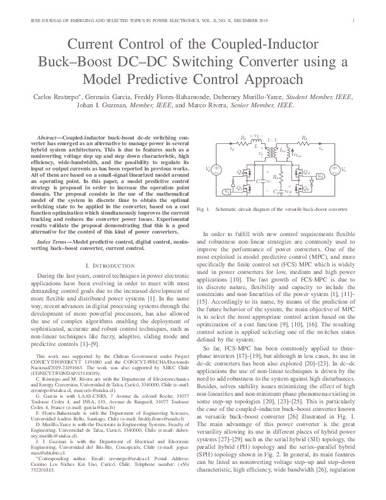Current Control of the Coupled-Inductor Buck–Boost DC–DC Switching Converter using a Model Predictive Control Approach
Subject:
Model Predictive Control, Digital Control, Noninverting Buck–Boost Converter, Current Control.
Publication date:
Editorial:
IEEE
Publisher version:
Citación:
Abstract:
Coupled-inductor buck-boost dc-dc switching converter has emerged as an alternative to manage power in several hybrid system architectures. This is due to features such as a noninverting voltage step-up and step-down characteristic, high efficiency, wide bandwidth, and the possibility to regulate its input or output currents as has been reported in previous works. All of them are based on a small-signal linearized model around an operating point. In this article, a model predictive control strategy is proposed to increase the operation point domain. The proposal consists in the use of the mathematical model of the system in discrete time to obtain the optimal switching state to be applied in the converter based on a cost function optimization, which simultaneously improves the current tracking and reduces the converter power losses. Experimental results validate the proposal demonstrating that this is a good alternative for the control of this kind of power converters.
Coupled-inductor buck-boost dc-dc switching converter has emerged as an alternative to manage power in several hybrid system architectures. This is due to features such as a noninverting voltage step-up and step-down characteristic, high efficiency, wide bandwidth, and the possibility to regulate its input or output currents as has been reported in previous works. All of them are based on a small-signal linearized model around an operating point. In this article, a model predictive control strategy is proposed to increase the operation point domain. The proposal consists in the use of the mathematical model of the system in discrete time to obtain the optimal switching state to be applied in the converter based on a cost function optimization, which simultaneously improves the current tracking and reduces the converter power losses. Experimental results validate the proposal demonstrating that this is a good alternative for the control of this kind of power converters.
ISSN:
Patrocinado por:
Chilean Government under Project CONICYT/FONDECYT 1191680 and the CONICYT-PFECHA/Doctorado Nacional/2019-21191663. The work was also supported by SERC Chile (CONICYT/FONDAP/15110019).
Collections
Files in this item

Métricas
Compartir
Estadísticas de uso
Metadata
Related items
Showing items related by title, author, creator and subject.




 ;
;